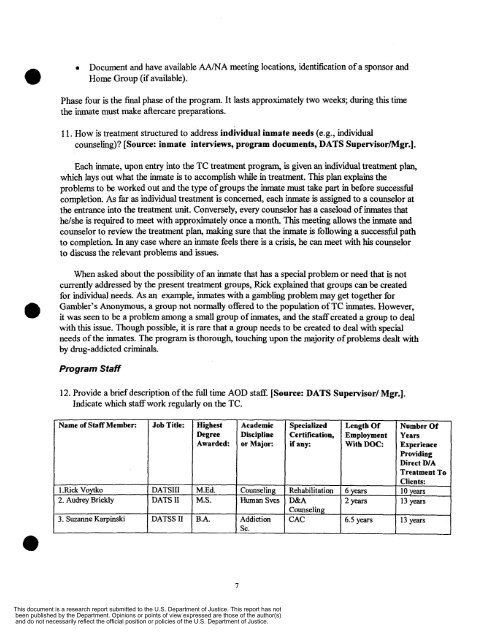0 - National Criminal Justice Reference Service
0 - National Criminal Justice Reference Service
0 - National Criminal Justice Reference Service
Create successful ePaper yourself
Turn your PDF publications into a flip-book with our unique Google optimized e-Paper software.
0 Document and have available M A meeting locations, identitication of a sponsor and<br />
Home Group (if available).<br />
Phase four is the final phase of the program. It lasts approximately two weeks; during this time<br />
the inmate must make aftercare preparations.<br />
1 1. How is treatment structured to address individual inmate needs (e.g., individual<br />
counseling)? [Source: inmate interviews, program documents, DATS Supervisor/Mgr.].<br />
Each inmate, upon entry into the TC treatment program, is given an individual treatment plan,<br />
which lays out what the inmate is to accomplish while in treatment. This plan explains the<br />
problems to be worked out and the type of groups the inmate must take part in before successhl<br />
completion. As far as individual treatment is concerned, each inmate is assigned to a counselor at<br />
the entrance into the treatment unit. Conversely, every counselor has a caseload of inmates that<br />
he/she is required to meet with approximately once a month. This meeting allows the inmate and<br />
counselor to review the treatment plan, making sure that the inmate is following a successhl path<br />
to completion. In any case where an inmate feels there is a crisis, he can meet with his counselor<br />
to discuss the relevant problems and issues.<br />
0<br />
When asked about the possibility of an inmate that has a special problem or need that is not<br />
currently addressed by the present treatment groups, Rick explained that groups can be created<br />
for individual needs. As an example, inmates with a gambling problem may get together for<br />
Gambler’s Anonymous, a group not normally offered to the population of TC inmates. However,<br />
it was seen to be a problem among a small group of inmates, and the staff created a group to deal<br />
with this issue. Though possible, it is rare that a group needs to be created to deal with special<br />
needs of the inmates. The program is thorough, touching upon the majority of problems dealt with<br />
by drug-addicted criminals.<br />
Program Staff<br />
12. Provide a brief description of the full time AOD staff. [Source: DATS Supervisor/ Mgr.].<br />
Indicate which staff work regularly on the TC.<br />
Name of Staff Member:<br />
1 .Rick Voytko<br />
2. Audrey Brickly<br />
3. Suzanne Karpinski<br />
Job Title: Highest Academic Specialized Length Of<br />
Degree Discipline Certification, Employment<br />
Awarded: or Major: if any: With DOC:<br />
DATSIII M.Ed. Counseling Rehabilitation 6 years<br />
DATSII M.S. HumanSvcs D&A 2 Y-<br />
Counseling<br />
DATSSII B.A. Addiction CAC 6.5 years<br />
sc.<br />
Number Of<br />
Experience<br />
Providing<br />
Direct DIA<br />
Treatment To<br />
Clients:<br />
13 years<br />
13 years<br />
I<br />
7<br />
This document is a research report submitted to the U.S. Department of <strong>Justice</strong>. This report has not<br />
been published by the Department. Opinions or points of view expressed are those of the author(s)<br />
and do not necessarily reflect the official position or policies of the U.S. Department of <strong>Justice</strong>.
















